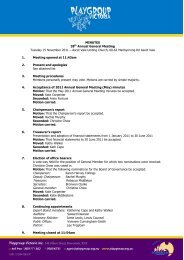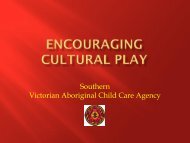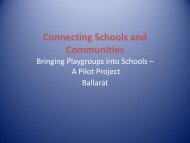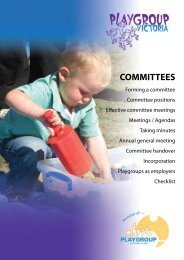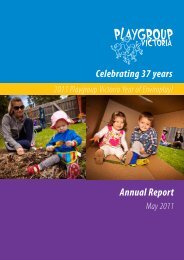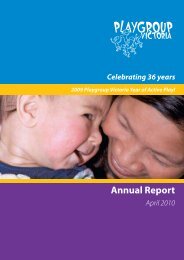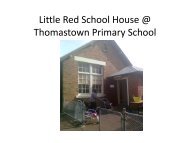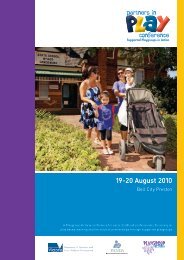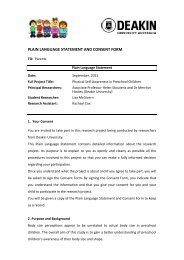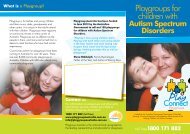to view ESSENTIAL READING on this module - Playgroup Victoria
to view ESSENTIAL READING on this module - Playgroup Victoria
to view ESSENTIAL READING on this module - Playgroup Victoria
You also want an ePaper? Increase the reach of your titles
YUMPU automatically turns print PDFs into web optimized ePapers that Google loves.
SAFE AND SUPPORTIVE PLAYGROUPS<br />
Safe playgroups<br />
Creating a safe playgroup<br />
Even if we give our playgroup-aged children loving<br />
care and close supervisi<strong>on</strong> we cannot always keep<br />
them from harm.<br />
Children can still trip, fall, bleed, bruise, get scratched,<br />
cut, burnt or bitten.<br />
But whether your playgroup is in homes or a public<br />
facility, you have a resp<strong>on</strong>sibility <str<strong>on</strong>g>to</str<strong>on</strong>g> provide a safe,<br />
healthy envir<strong>on</strong>ment for children. It is the child’s right<br />
<str<strong>on</strong>g>to</str<strong>on</strong>g> be supervised at all times.<br />
We can take positive acti<strong>on</strong> <str<strong>on</strong>g>to</str<strong>on</strong>g> lessen the chances of or<br />
s<str<strong>on</strong>g>to</str<strong>on</strong>g>p more serious injuries occurring.<br />
How many families make a safe<br />
playgroup<br />
For home playgroups <strong>Playgroup</strong> Vic<str<strong>on</strong>g>to</str<strong>on</strong>g>ria recommends<br />
around 6-8 families, for hall playgroups 10-15 families.<br />
Overcrowding can increase the risk of an accident<br />
occurring. C<strong>on</strong>sider the size of your meeting place and<br />
how many families are comfortable indoors <strong>on</strong> a wet<br />
day.<br />
Children's Services Regulati<strong>on</strong>s recommend 3.3 square<br />
metres per child for an indoor play space. <strong>Playgroup</strong>s<br />
are not bound by these regulati<strong>on</strong>s but are wise <str<strong>on</strong>g>to</str<strong>on</strong>g> use<br />
them as a guide.<br />
Decide, as a group, <strong>on</strong> a safe number of enrolled<br />
families for your playgroup. Take in<str<strong>on</strong>g>to</str<strong>on</strong>g> account the size<br />
of the venue, ages of the children and number of<br />
families with more than <strong>on</strong>e child attending.<br />
If you feel your playgroup is getting <str<strong>on</strong>g>to</str<strong>on</strong>g>o large <str<strong>on</strong>g>to</str<strong>on</strong>g> be safe:<br />
• start a new playgroup sessi<strong>on</strong><br />
• make a waiting list, or<br />
• refer families <str<strong>on</strong>g>to</str<strong>on</strong>g> other local playgroups.<br />
Develop a playgroup safety policy<br />
Involve every<strong>on</strong>e in making decisi<strong>on</strong>s about safety<br />
issues then put them in<str<strong>on</strong>g>to</str<strong>on</strong>g> a safety policy. Display your<br />
policy and make new playgroup members aware of it.<br />
Writing a safety policy<br />
1. Begin with a str<strong>on</strong>g statement defining safety and<br />
outlining your playgroup’s commitment <str<strong>on</strong>g>to</str<strong>on</strong>g> safety.<br />
Define who is resp<strong>on</strong>sible for safety regarding:<br />
− supervisi<strong>on</strong> of children<br />
− <str<strong>on</strong>g>to</str<strong>on</strong>g>ys and equipment<br />
− children going <str<strong>on</strong>g>to</str<strong>on</strong>g> the <str<strong>on</strong>g>to</str<strong>on</strong>g>ilet<br />
− fences, gates and doors<br />
− the playground and fixed equipment<br />
− car parking and transporting children<br />
− other issues related <str<strong>on</strong>g>to</str<strong>on</strong>g> play activities.<br />
2. List playgroup guidelines regarding:<br />
− infectious diseases<br />
− SunSmart<br />
− smoking<br />
− kitchen issues and hot drinks<br />
− other issues specific <str<strong>on</strong>g>to</str<strong>on</strong>g> your venue.<br />
3. Include emergency evacuati<strong>on</strong> procedures in cases<br />
of fire or trauma. See ‘Standard fire orders for<br />
playgroups’ <strong>on</strong> page 66.<br />
4. State where the following are kept and who is<br />
resp<strong>on</strong>sible for:<br />
− emergency numbers for fire<br />
− enrolment forms with pers<strong>on</strong>al details should<br />
any<strong>on</strong>e be injured or traumatised<br />
− first aid kit<br />
− accident, incident and injury book.<br />
5. Define how members can raise and report safety<br />
c<strong>on</strong>cerns and how these c<strong>on</strong>cerns will be handled.<br />
A safety policy is a living document. Regularly revise<br />
and update it <str<strong>on</strong>g>to</str<strong>on</strong>g> ensure your practices are c<strong>on</strong>sistent<br />
with your policy.<br />
Sharing the resp<strong>on</strong>sibility<br />
Each parent and caregiver attending a playgroup must<br />
be resp<strong>on</strong>sible for the welfare and safety of the<br />
child/ren they bring. There is also a group<br />
resp<strong>on</strong>sibility <str<strong>on</strong>g>to</str<strong>on</strong>g> ensure every child is safe.<br />
Keeping <strong>this</strong> in mind , remember that playgroups need<br />
<str<strong>on</strong>g>to</str<strong>on</strong>g> keep a balance between being safe and allowing the<br />
children <str<strong>on</strong>g>to</str<strong>on</strong>g> take the risks necessary <str<strong>on</strong>g>to</str<strong>on</strong>g> develop new<br />
skills.<br />
62 <strong>Playgroup</strong> Manual



